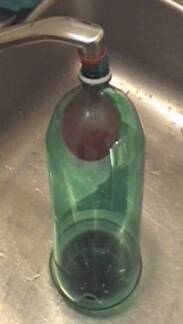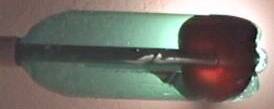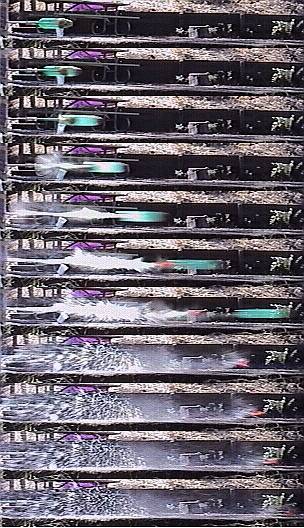A horizontal flight makes waves
One problem with launching rockets horizontally or at low angles is the resulting internal wave of water that perturbs the rocket, making it hard to control the flight path. This is illustrated in my high-speed video of a horizontal flight. If the horizontal bottle is the means of propelling a small race car, then the vehicle may become unstable for the same reason. Admittedly this is a problem that most water rocketeers do not experience, but—being an engineer—I decided to formulate a solution anyway. My idea is to place the water in a balloon in order to position the water symmetrically about the bottle axis. This should allow the bottle to fly straight.
Caution: horizontal and low-angle flights require extra safety measures because of the increased possibility of striking people and objects. You should not launch water rockets in this manner if you cannot take appropriate precautions.
Balloon technology
First I filled the balloon with the desired amount of water while it is inside the bottle. I released any residual air in the balloon and then tied the balloon closed.

I attached the bottle to the launcher. The launch tube pins the balloon to the end of the bottle. A light placed behind the bottle allows you to see how the balloon deforms around the launch tube:

The balloon tends to obstruct the air opening, with the funny result that a loud flatulence noise comes from the rocket while it is being filled with air.
The results
Below is a set of snapshots of the launch, taken 1/60 second apart using a video camera. Air pressure was around 50psi. There is a tennis ball taped to the nose of the bottle. A paper cup is supporting the bottle's weight while the bottle is mounted on the launcher.
Upon launch, the balloon stays mostly stationary while the bottle accelerates off the launch tube. Then the throat of the bottle collides with the balloon and the balloon ruptures, with no noticeable waves. The balloon carcass is ejected after the bottle has travelled about 1.5m—the balloon appears to contain some residual water at the time of ejection. The balloon and the bottle travel another 10m and 28m, respectively, before coming to rest on the asphalt. Despite the high-speed scraping on the blacktop, the bottle has no significant damage—gotta love the toughness of PET plastic.

It flies straight!
